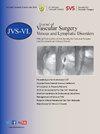Clinical outcomes after treatment of incompetent saphenous vein combined with segmental popliteal vein reflux
IF 2.8
2区 医学
Q2 PERIPHERAL VASCULAR DISEASE
Journal of vascular surgery. Venous and lymphatic disorders
Pub Date : 2024-05-27
DOI:10.1016/j.jvsv.2024.101918
引用次数: 0
Abstract
Objective
This study aimed to evaluate whether differences exist in the quality of life changes and complication rates after treatment of incompetent saphenous vein (ISV) based on the presence of segmental popliteal vein reflux (SPVR).
Methods
Patients who underwent treatment for ISV from July 2016 to July 2021 were included and divided into two groups: patients without deep venous reflux (DVR) and patients with SPVR. Patients with axial DVR, a history of deep vein thrombosis, a history of orthopedic surgery, previous venous treatment, and no postoperative follow-up were excluded from the study. Duplex ultrasound examination was performed preoperatively and at 6 and 12 months postoperatively.
Results
The study included 233 patients (398 limbs), and 50 (64 limbs) had SPVR. Differences were not observed in gender, age, body mass index, distribution of clinical class according to Clinical-Etiology-Anatomy-Physiology classification, laterality, treatment method, and preoperative Venous Clinical Severity Score or Aberdeen Varicose Vein Questionnaire scores between the two groups with SPVR or without DVR. Furthermore, the Venous Clinical Severity Score and Aberdeen Varicose Vein Questionnaire scores at 6 and 12 months postoperatively were improved in both groups, although without significant differences. A significant difference was not observed in the rate of postoperative complications between the groups based on the presence of SPVR (1.8% vs 1.6%: P = .896). The SPVR improvement rate after ISV treatment was 25% (16/64), and patient-reported outcomes in patients combined with SPVR improved independent of treatment modality, saphenous vein treatment section, and postoperative SPVR improvement.
Conclusions
Complication rates and clinical outcomes after ISV treatment did not differ in the presence of SPVR. In patients with SPVR, after ISV treatment, quality of life improved regardless of treatment modality, saphenous vein treatment section, and postoperative SPVR improvement.
治疗无功能隐静脉合并节段性腘静脉反流后的临床效果。
研究目的本研究旨在评估隐静脉闭锁(ISV)治疗后,生活质量的变化和并发症发生率是否因是否存在节段性腘静脉反流(SPVR)而存在差异:纳入2016年7月至2021年7月期间接受ISV治疗的患者,并将其分为两组:无深静脉回流(DVR)患者和有SPVR患者。有轴向深静脉回流、深静脉血栓(DVT)病史、骨科手术史、既往接受过静脉治疗以及术后未随访的患者不在研究范围内。术前、术后 6 个月和 12 个月进行了双相超声检查:研究共纳入 233 名患者(398 条肢体),其中 50 人(64 条肢体)进行了 SPVR。接受 SPVR 或未接受 DVR 的两组患者在性别、年龄、体重指数(BMI)、根据临床-病因-解剖-生理学(CEAP)分类的临床分级分布、侧位、治疗方法以及术前静脉临床严重程度评分(VCSS)或阿伯丁静脉曲张问卷(AVVQ)评分方面均未发现差异。此外,两组患者术后 6 个月和 12 个月的 VCSS 和 AVVQ 评分均有所改善,但无显著差异。根据是否存在 SPVR,两组的术后并发症发生率无明显差异(1.8% 对 1.6%:P = 1.00)。ISV治疗后的SPVR改善率为25%(16/64),合并SPVR患者的患者报告结果有所改善,与治疗方式、隐静脉治疗部位和术后SPVR改善情况无关:结论:ISV治疗后的并发症发生率和临床疗效与SPVR没有差异。对于合并 SPVR 的患者,ISV 治疗后生活质量的改善与治疗方式、隐静脉治疗部位和术后 SPVR 改善无关。
本文章由计算机程序翻译,如有差异,请以英文原文为准。
求助全文
约1分钟内获得全文
求助全文
来源期刊

Journal of vascular surgery. Venous and lymphatic disorders
SURGERYPERIPHERAL VASCULAR DISEASE&n-PERIPHERAL VASCULAR DISEASE
CiteScore
6.30
自引率
18.80%
发文量
328
审稿时长
71 days
期刊介绍:
Journal of Vascular Surgery: Venous and Lymphatic Disorders is one of a series of specialist journals launched by the Journal of Vascular Surgery. It aims to be the premier international Journal of medical, endovascular and surgical management of venous and lymphatic disorders. It publishes high quality clinical, research, case reports, techniques, and practice manuscripts related to all aspects of venous and lymphatic disorders, including malformations and wound care, with an emphasis on the practicing clinician. The journal seeks to provide novel and timely information to vascular surgeons, interventionalists, phlebologists, wound care specialists, and allied health professionals who treat patients presenting with vascular and lymphatic disorders. As the official publication of The Society for Vascular Surgery and the American Venous Forum, the Journal will publish, after peer review, selected papers presented at the annual meeting of these organizations and affiliated vascular societies, as well as original articles from members and non-members.
 求助内容:
求助内容: 应助结果提醒方式:
应助结果提醒方式:


